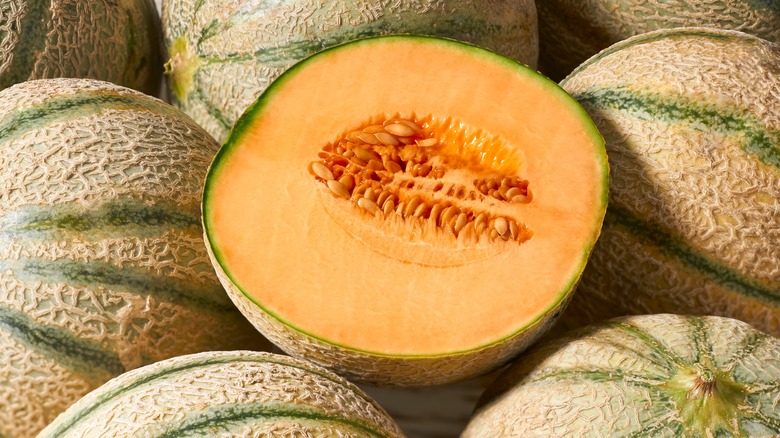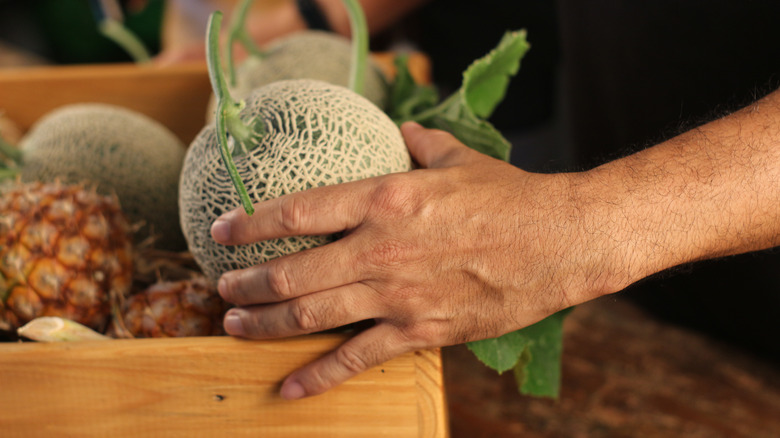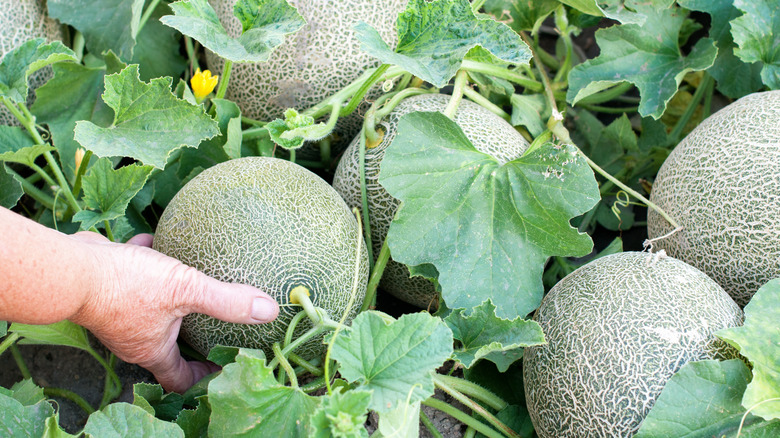How To Choose The Tastiest Cantaloupe At The Store
For an edible delight that's 90% water, the cantaloupe amazes the senses with dense, aromatic sweetness. This renowned member of the Cucumis melo species goes by many names across the world, including the American-named "cantaloupe," South African "spanspek," French-bred "charentais," and a favorite in Australia, the "rockmelon." Regardless of which moniker this net-skinned wonder answers to, one thing is universal: you want it juicy and sweet. That means picking one at peak ripeness, which isn't as easy as it sounds.
If properly stored and transported after harvesting, cantaloupes can last up to two weeks or more in consistent temperatures of 36 to 41 degrees Fahrenheit. Ideally, they'll be at peak ripeness by the time they reach your local grocery store. But unlike thinner-skinned fruits, cantaloupes hide their secrets inside dense, rough, outer skins with marvelously intricate lacy patterns. That means squishing or poking is unlikely to reveal whether that melon in your hand harbors a naturally sweet, summery succulence.
Fortunately, these ground-hugging or trellis-climbing beauties have been around for ages, leaving some handed-down wisdom on choosing the tastiest one. The ripe-and-ready status of a cantaloupe comes down to four sensory indications: smell, color, sound, and touch. They're all things you can unobtrusively perform in the produce section of a grocery, farmer's market, or roadside fruit stand.
Put your senses to work for the tastiest cantaloupe
Snagging a cantaloupe in the heart of summer increases the likelihood of it being lusciously ripe, juicy, and sweet. But even in high season, that's not guaranteed. So put your senses to work, first tapping into your sense of smell. A primary indicator of a ripe cantaloupe is a deeply sweet, fruity fragrance, with gentle musky tones.
Next, eyeball the melon closely. You're looking for a uniformly tan or creamy yellow color rather than green, which would indicate it came off the vine too early. Likewise, you want the net-like texture deeply etched into the rind; if it's too smooth, it's likely unripe. Though melons may look earthy with the stem still attached, avoid that one — the stem of a truly ripe cantaloupe detaches very easily and is unlikely to stay in place during harvest, transportation, and handling.
Let your hands contribute to the process. Find the end spot where the stem once lived, and press gently on the indentation. A hard stem spot means it's less likely to be ripe, while a mushy one indicates it's reaching the end of its "best by" window. You should also pick up a couple of cantaloupes and compare the weight. Heaviness suggests a plump, ripe melon.
Finally, it's perfectly fine to tap or thump the cantaloupe, similar to how some people listen to watermelons. If you get a hollow and high sound, put it down. Low and deep means take it home.
More considerations when buying cantaloupe
There's another major consideration when picking which melon to grace your kitchen table or picnic: the potential for mold and damage. That netted texture on the cantaloupe rind, though admirable in its intricacy, offers lots of little crevices for bacteria to congregate, potentially causing foodborne illness, as noted by the U.S. Food and Drug Administration (FDA).
Since these vine fruits often grow on the ground, they're more susceptible to contamination by critters, chemical-laden groundwater, and pathogens. Always check for patches of mold on a cantaloupe, and look for bruising or damage that may weaken the skin and allow bacteria to enter the edible interior flesh.
Even with no evidence of contamination, thoroughly wash the exterior before slicing into the melon. The act of cutting into an unwashed melon is particularly risky, as it may introduce harmful contaminants to the fruit's interior. Continued slicing with the same knife could exponentially multiply the problem. Fortunately, it's an easy fix with a vegetable brush and some running water.
Considering the luscious summer sweetness of a cantaloupe, the extra care and effort are well warranted. And that's not even counting the mega infusion of health-enhancing properties inside that melon, including powerful antioxidants, vitamins A and C, dietary fiber, potassium, and more.



